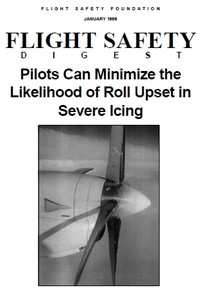Better To Prepare Now Than When Ice Is Forming On The
Wings
 A Safety Alert For Operators (SAFO) issued by the FAA this week
encourages operators to ensure that all pertinent meteorological
information is provided to flight crewmembers and dispatchers, both
for preflight planning and in-flight decision making when the route
of flight may be near areas of potentially hazardous weather
conditions with a special emphasis on icing.
A Safety Alert For Operators (SAFO) issued by the FAA this week
encourages operators to ensure that all pertinent meteorological
information is provided to flight crewmembers and dispatchers, both
for preflight planning and in-flight decision making when the route
of flight may be near areas of potentially hazardous weather
conditions with a special emphasis on icing.
On October 31, 1994, an accident involving an ATR-72 occurred
while the airplane was en route from Indianapolis to Chicago. Post
accident investigation concluded the likely presence of freezing
drizzle aloft. Freezing drizzle and freezing rain aloft are
considered synonymous with supercooled large droplets (SLD), i.e.
those icing conditions containing droplets larger than those
required to be demonstrated in aircraft icing certification
criteria. SLD may result in ice formation beyond the capabilities
of the airplane’s ice protection system to provide adequate
ice protection. While the flight crewmembers of the ATR-72 were not
aware that the icing conditions they encountered could cause
dramatic airplane control difficulties, they were aware of the
presence of icing.
As a result of the ATR-72 accident investigation, the NTSB
expressed concerns that approved air carrier training programs may
not fully address procedures, should flight into SLD conditions be
encountered. The NTSB expressed concern about a lack of pertinent
weather information dissemination to flight crewmembers and
dispatchers as well.
The SAFO states that safe operations during in-flight icing
conditions requires flight crewmembers to be aware of the potential
dangers of in-flight icing and under what conditions in-flight
icing may be encountered. Knowing the type of in-flight icing and
where in-flight icing might be encountered is essential to
preflight planning and in-flight decision making, should severe
icing be encountered. Information is available to both flight
crewmembers and dispatchers through airman’s meteorological
information (AIRMET), significant meteorological information
(SIGMET), Center Weather Advisories (CWA), Current Icing Potential
(CIP), Forecast Icing Potential (FIP), and the hazardous in-flight
weather advisory service (HIWAS).
 After the ATR-72 accident, the Federal Aviation Administration
(FAA) issued several aircraft specific airworthiness directives
(AD) concerning procedures to identify severe icing conditions,
knowledge of the airplanes certification limits, and procedures to
safely exit in-flight icing conditions when necessary. In September
1995, the FAA published a document entitled, “Roll
Upset in Severe Icing,” which describes icing conditions
outside the airplane’s certification icing envelope and
provides information about the background, preventative measures,
symptoms, and corrective measures on the hazards of roll upset
associated with severe in-flight icing.
After the ATR-72 accident, the Federal Aviation Administration
(FAA) issued several aircraft specific airworthiness directives
(AD) concerning procedures to identify severe icing conditions,
knowledge of the airplanes certification limits, and procedures to
safely exit in-flight icing conditions when necessary. In September
1995, the FAA published a document entitled, “Roll
Upset in Severe Icing,” which describes icing conditions
outside the airplane’s certification icing envelope and
provides information about the background, preventative measures,
symptoms, and corrective measures on the hazards of roll upset
associated with severe in-flight icing.
The FAA recommends that directors of safety and directors of
operations (part 121 and 135), as well as training managers for all
operators of turbo prop aircraft are encouraged to review and
amend, if required, flight crewmember and dispatcher training
programs to include:
- A review of meteorological conditions likely to cause freezing
drizzle and freezing rain aloft (SLD conditions).
- Identification of weather information sources and their use
relative to in-flight icing. This should include use of
AIRMET’s, SIGMET’s, CWA’s, HIWAS and CIP/FIP
information, as appropriate, for the flight crewmember’s and
dispatcher’s pre-flight planning and in-flight decision
making processes.
- Discussion of procedures, including company and ATC procedures,
for pilot weather reports (PIREP) on severe icing to include
reporting procedures, content and use of PIREP’s.
- Discussion of information provided to flight crewmembers
including identification of severe icing conditions associated with
freezing rain and freezing drizzle, immediate exit procedures
should severe icing conditions be encountered, and ATC
procedures.
- A review of the FAA publication, “Roll Upset in
Severe Icing”.
The SAFO was been developed in response to NTSB safety
recommendations A-96-48, A-96-50, A-96-61 and A-96-67; and
supersedes Flight Standards Information Bulletin for Air
Transportation (FSAT) 97-03.
 ANNouncement: Now Accepting Applications For Oshkosh 2024 Stringers!!!
ANNouncement: Now Accepting Applications For Oshkosh 2024 Stringers!!! Aero-News: Quote of the Day (06.13.24)
Aero-News: Quote of the Day (06.13.24) ANN's Daily Aero-Term (06.13.24): Dead Reckoning
ANN's Daily Aero-Term (06.13.24): Dead Reckoning ANN's Daily Aero-Linx (06.13.24)
ANN's Daily Aero-Linx (06.13.24) ANN FAQ: How Do I Become A News Spy?
ANN FAQ: How Do I Become A News Spy?




